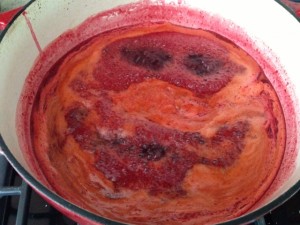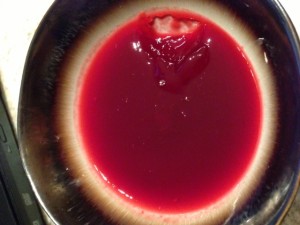Jul 23 2013
Wineberry Jammelly
Ah, those hot, lazy days of summer…
Well, maybe not so lazy. Mid-July typically means jam-making at my house, and this year is no exception.
Last year, we had to contend with such an abundance of plums that I was able to make not only jam, but also ice-cream, plum butter, and plum vodka. This year, however, yielded not a single fruit from that tree, and so I had to turn to other sources. Fortunately, we have a rather large patch of wineberries growing in front of our house, which is what I ended up using.
Wineberries, you ask? As Eddie Izzard would say: “What on Earth is that?”
Don’t feel bad. I have lived in my current house for 16 years, and just found out this week that this is what they’re called. I’m not proud. Rubus phoenicolasius, a.k.a wineberry, is a species of raspberries that is originally from East Asia, and was imported to America as an ornamental plant. It subsequently escaped cultivation and established as a wild growing bramble, quite a common one in our neck of the woods (Eastern U.S.).
Wineberries are sweet and tart, unsurprisingly raspberry-like, and are just the perfect fruit to preserve for those cold winter days when you need a reminder of what summer tastes like, with one caveat: they are VERY seedy (and by this, I don’t mean that they’re the kind of fruit you can’t bring home to mother). If you simply cook the whole fruit with sugar and turn it into jam that way (as you might with other berries), the result might be much crunchier than most people would enjoy. Not to worry, though, as there are a few easy ways around this issue:
1. If you have a juicer, simply process the berries (after carefully washing them – they are quite delicate and fall apart easily); that is what I did, and the juice I collected was still full of fruit pulp, dark red, lovely, and entirely devoid of seeds. The resulting product, after cooking with sugar, is somewhere between a jam and a jelly, hence, a jammelly.
2. After washing the berries, cook them on low heat until they begin to fall apart, and process in a food mill; The result will be much as with a juicer.
3. Do as above but until the berries fall completely apart, and filter through a cheesecloth. In this manner, you will obtain a clear juice that will yield a true jelly once cooked.
One final note: when making jams or jellies, recipes will often measure both fruit and sugar by volume rather than by weight. I feel this is a mistake which can yield a product of sub-standard quality. It is worth investing in a kitchen scale for this purpose, as it is important to determine the correct weight of your ingredients.
Wineberry “Jammelly”
2 lbs (1 kg) processed berry juice
29 oz (800 gr) granulated sugar
juice of 1/2 lemon
Bring mixed juice and sugar to a rapid boil in a large dutch oven (copper, or enameled cast iron, is best). Make sure your juice and sugar fit comfortably in the pot, as the jam will foam and might boil over. Stir occasionally.
Boil for about 10 minutes and add lemon juice. You will know your jam is ready when a spoonful placed on a plate in the fridge for a couple of minutes has thickened to the right consistency. If the jam is still too liquid, let it cook a little while longer. When ready, remove from heat and skim the foam off the top of the jam.
While the jam is still hot, fill your containers (previously washed then dipped in boiling water), cover very tightly with clean and sterile lids (making sure the rim of the jar is very clean before placing the lid on), and invert the jars on the counter. Let the jars cool fully before turning them back up – this will give them an airtight seal. In this way, you avoid having to sterilize the jars in a hot water bath, which might spoil the jam by overcooking it. I have used this method for years, and have not yet had a single jar spoil, even after months in storage.
Enjoy on good buttered toast, when you want a sweet reminder of those hot, sweet, not-so-lazy days of summer!




![IMG_0312[1]](http://flexitarian.christinesusskind.com/wp-content/uploads/2013/01/IMG_03121-e1357054893695-225x300.jpg)
![IMG_0260[1]](http://flexitarian.christinesusskind.com/wp-content/uploads/2013/01/IMG_02601-300x225.jpg)
![IMG_0278[1]](http://flexitarian.christinesusskind.com/wp-content/uploads/2012/12/IMG_02781-300x225.jpg)
![IMG_0310[1]](http://flexitarian.christinesusskind.com/wp-content/uploads/2012/12/IMG_03101-300x225.jpg)
![IMG_0261[1]](http://flexitarian.christinesusskind.com/wp-content/uploads/2012/12/IMG_02611-e1356961339630-225x300.jpg)
![IMG_0286[1]](http://flexitarian.christinesusskind.com/wp-content/uploads/2012/12/IMG_02861-300x225.jpg)
